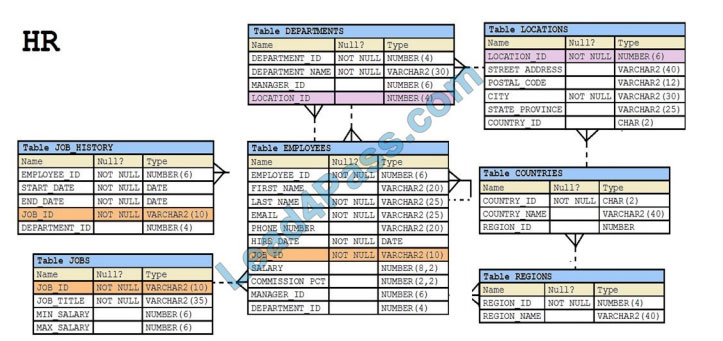Tips and practical test questions and answers for getting Oracle exam certification (1z0-064 exam, 1z0-066 exam, 1z0-134 exam, 1z0-071 exam)(First: Exam practice test, Second: leads4pass Oracle expert.) You can get free Oracle exam practice test questions here.
Or choose: https://www.leads4pass.com/oracle.html Study hard to pass the exam easily!
Table of Contents:
- Latest Oracle 1z0-064 exam List
- Latest Oracle 1z0-066 exam List
- Latest Oracle 1z0-134 exam List
- Latest Oracle 1z0-071 exam List
- leads4pass Year-round Discount Code
- What are the advantages of leads4pass?
Latest Oracle 1z0-064 exam List
Oracle Database 12c: Performance Management and Tuning: https://education.oracle.com/oracle-database-12c-performance-management-and-tuning/pexam_1Z0-064
Latest updates Oracle 1z0-064 exam practice questions(1-5)
QUESTION 1
You are administrating a database that supports a DSS workload. Syntactically similar queries using joins and
aggregate functions are frequently executed by users to fetch data from remote databases by using database links.
Which three tasks should you perform to improve the performance of these queries?
A. Ensure that the RESULT_CACHE_MAX_RESULT parameter is set to 100.
B. Ensure that the RESULT_CACHE_REMOTE_EXPIRATION parameter is set to a nonzero value for the local
instance.
C. Ensure that the RESULT_CACHE_MAX_SIZE parameter is set to a nonzero value on the local database instance.
D. Ensure that the RESULT_CACHE_MAX_SIZE parameter is set to a nonzero value on both the local and remote
database instances.
E. Ensure that the RESULT_CACHE_MAX_SIZE parameter is set to a nonzero value on the remote database instance.
F. Ensure that the RESULT_CACHE_MAX_MODE parameter is set to FORCE for the local instance.
G. Ensure that the RESULT_CACHE_MODE parameter is set to FORCE for remote database instances.
Correct Answer: BCF
QUESTION 2
Which two result in the least internal fragmentation within segments and the least external fragmentation within
tablespaces? (Choose two.)
A. automatic segment space managed segments
B. locally managed tablespaces with uniform extent size
C. freelist managed segments with one freelist
D. dictionary managed tablespaces
E. locally managed tablespaces that were converted from dictionary managed tablespaces
F. freelist managed segments with multiple freelists
Correct Answer: AD
QUESTION 3
In which three situations can dynamic statistics be used? (Choose three.)
A. when the sampling time is a small fraction of the total time for a query
B. when an execution plan is suboptimal because of complex predicates
C. when extended statistics are not available for SQL statements that use complex predicates
D. when a query is on a partitioned table with a global index
E. when index statistics are missing on a column that is used in SQL statements with highly selective filters
Correct Answer: BCD
QUESTION 4
Which two statements are true about the interpretation of Buffer Cache Hit Ratio in the Instance Efficiency Percentages
section of an AWR report? (Choose two.)
A. A high value indicates that the buffer cache is adequately sized for the current workload.
B. Poor hit ratios indicate that a large number of indexed lookups or small table scans are being performed.
C. A low hit ratio does not necessarily imply that increasing the size of the buffer cache will improve performance.
D. A high hit ratio may indicate that repeated scanning of the same large table or index is being performed.
E. A low hit ratio indicates that a KEEP buffer pool should be configured based on the size of the largest object
accessed in the buffer cache.
Correct Answer: CE
QUESTION 5
You are administering a database that supports an OLTP workload. RESULT_CACHE_MODE is set to the default value
and a result cache is configured for the instance. Multiple sessions execute syntactically similar queries without dblinks,
containing functions and expressions, on tables with no DML activity. Some users complain about poor performance of
these queries.
You investigate and find that the queries are frequently performing physical I/O, even though the results fetched by the
queries are similar.
Which two actions do you recommend to overcome the problem affecting these queries? (Choose two.)
A. Set the RESULT_CAHCE_MODE parameter to FORCE for the instance.
B. Use the result cache hint in the queries.
C. Use bind variables for similar queries instead of literals.
D. Set the RESULT_CACHE_REMOTE_EXPIRATION parameter to a nonzero value.
E. Configure the KEEP pool and cache the queried tables used in the KEEP pool.
Correct Answer: AB
[PDF q1 – q13] Free Oracle 1z0-064 pdf dumps download from Google Drive: https://drive.google.com/open?id=1YMbyz8O8LxB5MNN3tPdm2AWxnx28l_Wx
Full Oracle 1z0-064 exam practice questions: https://www.leads4pass.com/1z0-064.html (Total Questions: 119 Q&A)
Latest Oracle 1z0-066 exam List
1Z0-066 – Oracle University:https://education.oracle.com/oracle-database-12c-data-guard-administration/pexam_1Z0-066
Latest updates Oracle 1z0-066 exam practice questions (1-5)
QUESTION 1
Which three statements are true about standby redo logs in a Data Guard configuration with no Oracle Streams or
Goldengate configured?
A. They are required on a logical standby for real-time apply
B. They are required only for synchronous redo transport.
C. Only standby databases can write redo to them.
D. It is recommended to have them on the primary database.
E. They are required on a physical standby for real-time apply.
F. The LGWR process writes to them on a standby database.
Correct Answer: ACE
QUESTION 2
Which two are true about management of a far sync instance when using the Data Guard Broker?
A. A far sync instance is in a disabled state in the broker configuration immediately after adding it
B. A far sync instance that has its RedoRoutes property set may not be disabled in the broker configuration.
C. Broker management of a far sync instance may only be disabled with the disable configuration DGMGRL command.
D. A far sync instance need not exist before adding it to the broker configuration but may not be enabled until created
Correct Answer: AB
QUESTION 3
Which two Data Guard monitoring activities may be performed using Enterprise Manager Cloud Control?
A. monitoring the redo apply rate on a physical standby
B. monitoring the redo apply rate on a logical standby
C. monitoring the undo generation rate on a logical standby
D. monitoring the redo apply rate on a snapshot standby
E. monitoring the transport lag
F. monitoring the undo generation rate on the primary
Correct Answer: AE
QUESTION 4
Examine the Data Guard configuration: DGMGRL> show configuration Configuration -Animals Protection Mode:
MaxAvailability Databases: dogs- Primary database
sheep- (*) Physical standby database cats- Physical standby database Fast-Start Failover: ENABLED Configuration
Status: SUCCESS What happens if you issue “switchover” to sheep;” at the DGMGRL prompt?
A. The switchover succeeds but Dogs need to be reinstated
B. The switchover succeeds but Fast-Start Failover is suspended.
C. The switchover succeeds and Cats become the new failover target.
D. The switchover succeeds and Dogs become the new failover target
E. it results in an error indicating that a switchover is not allowed.
Correct Answer: D
QUESTION 5
Examine the Data Guard configuration: DGMGRL > show configuration; Configuration-Animals
Protection Mode MaxPerformance Databases dogs-Primary database sheep-Snapshot standby database catsSnapshot standby database Fast-Start Failover: DISABLED Configuration Status: SUCCESS
You receive an error while attempting to raise the protection mode to Maximum Availability:
DGMGDRL> edit configuration set protection mode as max availability;
Error ORA-16627 operation disallowed since no standby databases would remain to support protection mode Failed.
Identify two statements that you can execute, either one of which will enable successful raising of the protection mode to
Maximum Availability.
A. DGMGRL> convert database sheep to physical standby;
B. DGMGRL> convert database cats to physical standby;
C. DGMGRL> edit database dogs set property LogXptMode= fastsync;
D. DGMGRL> edit database sheep set property LogXptMode= fastsync;
E. DGMGRL> edit database cats set property LogXptMode= sync;
Correct Answer: BE
[PDF q1 – q13] Free Oracle 1z0-066 pdf dumps download from Google Drive: https://drive.google.com/open?id=1AMHWCQE-jgwSJH6yC7KQn0icCbK3kCoT
Full Oracle 1z0-066 exam practice questions: https://www.leads4pass.com/1z0-066.html (Total Questions: 204 Q&A)
Latest Oracle 1z0-134 exam List
Oracle WebLogic Server 12c: Advanced Administrator II:https://education.oracle.com/oracle-weblogic-server-12c-advanced-administrator-ii/pexam_1Z0-134
Latest updates Oracle 1z0-134 exam practice questions (1-5)
QUESTION 1
Your organization is using a Multi data source (MDS) on WebLogic Server to support applications connecting to an
Oracle RAC database. You have been tasked with configuring a new callback handler for the MDS. Which two
statements are true concerning related MDS options and behavior? (Choose two.)
A. Callback handlers are optional when using the Failover MDS Algorithm.
B. If the Failover Callback Handler attribute is set on the MDS, the Test Frequency attribute is no longer used.
C. Callback handlers are called for both failover and failback decisions.
D. You can register only one callback handler for each WebLogic server.
Correct Answer: CD
C: A callback handler used to control the failover and failback within a multi-data source must include an implementation
of the weblogic.jdbc.extensions.ConnectionPoolFailoverCallback interface.
D: You can register a callback handler with WebLogic Server that controls when a multi-data source with the Failover
algorithm fails over connection requests from one JDBC data source in the multi-data source to the next data source in
the list.
Incorrect Answers:
B: The frequency of these tests is controlled by the Test Frequency Seconds attribute of the multi-source. The default value
for Test Frequency is 120 seconds, so if you do not specifically set a value for the option, the multi-data source will test
disabled data sources every 120 seconds.
Reference: http://docs.oracle.com/cd/E23943_01/web.1111/e13737/jdbc_multidatasources.htm#JDBCA223
QUESTION 2
You are analyzing the JMSDeliveryMode header field for all the messages for all the queues deployed to your
JMSServer. Which two values do you expect to find for this header? (Choose two.)
A. PERSISTENT
B. NON_PERSISTENT
C. TRANSIENT
D. PERMANENT
E. MULTIMODE
F. EXACTLY_ONCE
Correct Answer: AB
JMSDeliveryMode specifies PERSISTENT or NON_PERSISTENT messaging. Reference:
http://docs.oracle.com/cd/E12840_01/wls/docs103/jms/fund.html
QUESTION 3
You are using the administration console to monitor messages in a queue. Which three tasks can be performed while
doing this monitoring? (Choose three.)
A. Create a new message in the queue.
B. Duplicate a message.
C. Monitor the content of a message.
D. Delete the message from the queue.
E. Merge two messages.
F. Alter the ordering of the messages.
Correct Answer: CDF
QUESTION 4
You want to create a WebLogic Server (WLS) Work Manager with a Response Time Request Class of one second. You
start to create the following WLST script:
Which two can replace the missing sequence to finish this script? (Choose two.)
A. cmo.addTarget(getMBean(\\’/Servers/ManagedServer\\’))
cd(\\’edit:/SelfTuning/wls_domain/WorkManagers/MyWorkManager\\’) cmo.setResponseTimeRequestClass(getMBean
(\\’/SelfTuning/wls_domain/ResponseTimeRequestClasses/MyResponseTime\\’))
B. managedServer=getMBean(\\’/Servers/ManagedServer\\’) cmo.addTarget(managedServer)
cmo.setWorkManaqer(getMBean(\\’/SelfTuning/wls_domain/WorManagers/MyWorkManager\\’))
C. cd(\\’edit:/Servers/ManagedServer\\’) cmo.addTarget(getMBean
(\\’/SelfTuning/wls_domain/ResponseTimeRequestClasses/MyResponseTime\\’)) cmo.addTarget
(getMBean(\\’/SelfTuning/wls_domain/WorkManagers/MyWorkManager\\’))
D. managedServer=getMBean(\\’/Servers/ManagedServer\\’) cmo.addTarget(managedServer)
cd(\\’edit:/SelfTuning/wls_domain/WorkManagers/MyWorkManager\\’) cmo.setResponseTimeRequestClass(getMBean
(\\’/SelfTuning/wls_domain/ResponseTimeRequestClasses/MyResponseTime\\’))
E. cmo.addTarqet(\\’/Servers/ManagedServer\\’) cd(\\’/SelfTuning/wls_domain/WorkManagers/MyWorkManager\\’)
cmo.setResponseTimeRequestClass (\\’/SelfTuning/wls_domain/ResponseTimeRequestClasses/MyResponseTime\\’)
Correct Answer: AD
Reference: http://docs.oracle.com/cd/E12839_01/apirefs.1111/e13952/pagehelp/J2EEappworkresponsetimerequestclassconfigtitle.html
QUESTION 5
Which three statements are correct regarding the WLST to create command? (Choose three.)
A. When the create command is used with WLST online, the connection must be to the administration server.
B. The type of MBean being created must be a child type of the current management object.
C. The correct order of the mandatory parameters for the create statement is a name followed by childMBeanType.
D. The create command is used to create any configuration or runtime management bean.
E. The create command returns a WLSTProgress object.
Correct Answer: ABC
A: When using the create command with WLST online you must be connected to an Administration Server.
B: Child types must be created under an instance of their parent type.
C: Syntax: create(name, childMBeanType, [baseProviderType])
The Create command creates a configuration bean of the specified type for the current bean.
Incorrect Answers:
D: The create command returns a stub for the newly created configuration bean. It can\\’t create a runtime management
bean.
E: The create command returns a stub for the newly created configuration bean.
Reference: https://docs.oracle.com/cd/E13222_01/wls/docs92/config_scripting/reference.html#wp1081543
[PDF q1 – q13] Free Oracle 1z0-134 pdf dumps download from Google Drive: https://drive.google.com/open?id=1RbknGHaaNc-EyhqjGe7P1Yvbedhk-Adi
Full Oracle 1z0-134 exam practice questions: https://www.leads4pass.com/1z0-134.html (Total Questions: 125 Q&A)
Latest Oracle 1z0-071 exam List
Oracle Database SQL | 1Z0-071 – Oracle University:https://education.oracle.com/oracle-database-sql/pexam_1Z0-071
Latest updates Oracle 1z0-071 exam practice questions (1-5)
QUESTION 1
View the Exhibit and examine the data in the PRODUCT_INFORMATION table.
Which two tasks would require subqueries? (Choose two.)
A. displaying all the products whose minimum list prices are more than the average list price of products having the status
orderable
B. displaying the total number of products supplied by supplier 102071 and having product status OBSOLETE
C. displaying the number of products whose list prices are more than the average list price
D. displaying all supplier IDs whose average list price is more than 500
E. displaying the minimum list price for each product status
Correct Answer: AC
QUESTION 2
Evaluate the following query
What is the correct output of the above query?
A. +00-300, +00-650, +00 11:12:10.123457
B. +25-00, +54-02, +00 11:12:10.123457
C. +00-300, +54-02, +00 11:12:10.123457
D. +25-00, +00-650, +00 11:12:10.123457
Correct Answer: B
QUESTION 3
In which three situations does a transaction complete?
A. when a PL/SQL anonymous block is executed
B. when a DELETE statement is executed
C. when a ROLLBACK command is executed
D. when a data definition language (DDL) statement is executed
E. when a TRUNCATE statement is executed after the pending transaction
Correct Answer: CDE
References: https://docs.oracle.com/cd/B19306_01/server.102/b14220/transact.htm
QUESTION 4
View the Exhibit and examine the description of the EMPLOYEES table. (Choose two.)
You executed this SQL statement:
SELECT first_name, department_id, salary FROM employees ORDER BY department_id, first_name, salary desc;
Which two statements are true regarding the result? (Choose two.)
A. The values in the SALARY column would be returned in descending order for all employees having the same value in
the DEPARTMENT_ID and FIRST_NAME column.
B. The values in the FIRST_NAME column would be returned in ascending order for all employees having the same
value in the DEPARTMENT_ID column.
C. The values in the SALARY column would be returned in descending order for all employees having the same value in
the DEPARTMENT_ID column.
D. The values in all columns would be returned in descending order.
E. The values in the FIRST_NAME column would be returned in descending order for all employees having the same
value in the DEPARTMENT_ID column.
Correct Answer: AB
QUESTION 5
Which two statements are true regarding the execution of the correlated subqueries? (Choose two.)
A. The nested query executes after the outer query returns the row.
B. The nested query executes first and then the outer query executes.
C. The outer query executes only once for the result returned by the inner query.
D. Each row returned by the outer query is evaluated for the results returned by the inner query.
Correct Answer: AD
[PDF q1 – q13] Free Oracle 1z0-071 pdf dumps download from Google Drive: https://drive.google.com/open?id=1OTh5tB-PbSJFGXTMPNYMVX6mVJahndhs
Full Oracle 1z0-071 exam practice questions: https://www.leads4pass.com/1z0-071.html (Total Questions: 361 Q&A)
leads4pass Year-round Discount Code

What are the advantages of leads4pass?
leads4pass employs the most authoritative exam specialists from Oracle, Cisco, EMC, CompTIA, etc. We update exam data throughout the year. Highest pass rate! We have a large user base. We are an industry leader!
Choose leads4pass to pass the exam with ease!

Summarize:
It’s not easy to pass the Oracle exam, but with accurate learning materials and proper practice, you can crack the exam with excellent results. https://www.leads4pass.com/oracle.html provides you with the most relevant
learning materials that you can use to help you prepare.